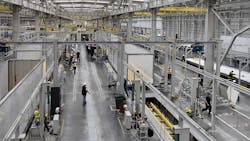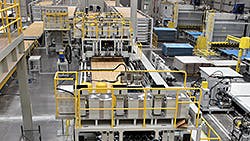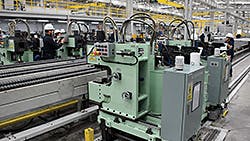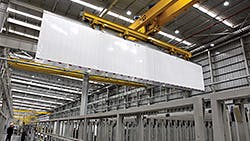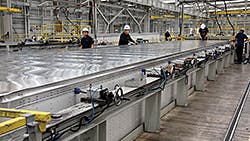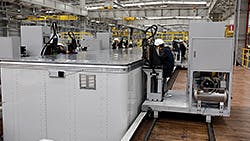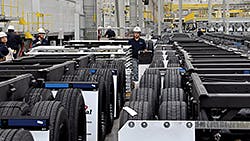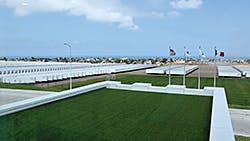Here’s what happens when Hyundai engineers team up to design a trailer plant
Hyundai Translead just posted its best year in the company’s history. And with the opening of a second plant in Mexico last year, it now has the capacity to do even more.
The new facility is expected to add 30,000 trailers to Hyundai’s capacity. It is 40 minutes southwest of the Hyundai plant in Tijuana. That facility alone built more than 45,000 trailers in 2015, the year before Hyundai opened the new plant in Rosarito.
The new facility teems with new technology, which is exactly what President Kenny Lee expected. Lee had served as sales manager for the San Diego-based trailer manufacturer prior to serving in other Hyundai operations elsewhere. After more than 10 years, Lee returned, this time as president. And he found the plant in Tijuana just as he had left it.
In the competitive world of automobile manufacturers, where Lee had spent the previous 10+ years, progress is not measured by doing things the way they always have been done. Hyundai wanted its trailer operation to be like its automobile division—constantly improving quality and efficiency.
“I had worked for Translead as sales manager,” Lee says. “After I left, I saw things changing everywhere else I worked at Hyundai/Kia. More technology. More efficient methods.
Year after year, sales were growing, and the company was producing more trailers. Management knew that they needed to take major steps for the future, not just incremental changes. But they did not want to interfere with production at a time when demand and production was growing.
And demand was growing. Twenty years ago, the company was the 13th largest trailer manufacturer in North America, according to the Trailer/Body Builders annual survey of North American trailer manufacturers. Hyundai built 3,445 trailers in 1997. Last year the company finished second and, with production of 50,706 trailers in 2016, Hyundai was one of the few manufacturers to build more trailers than in 2015 when the industry posted a record year.
Even before the record year, though, management concluded the time was right for a new plant to complement the company’s maquiladora manufacturing plant in Tijuana.
“It was time for us to step up,” Lee says.
Step up they did. The company acquired a 350-acre site less than 40 miles from Translead headquarters in San Diego. Hyundai broke ground in November, 2015. By August 2016, the 12-acre (548,000-sq-ft) plant was in its pre-production phase.
Today the plant is producing 120 composite and sheet-and-post trailers per day and employs 2,400 people.
High quality, high production
Hyundai had multiple goals in opening its second plant in the greater Tijuana area. They included:
• Productivity. The plant was designed to build 30,000 trailers annually.
• Quality. When Hyundai introduced its automobiles to the North American market, the company used a 100,000-mile warranty to back up its claim that its cars are durable and reliable. Top management filled the plant with many of the production and management concepts used to manufacture its cars and SUVs.
• Cost reduction. To accomplish both productivity, quality, and cost reduction, Hyundai tapped the expertise of its automotive engineers to partner with Translead engineers to develop a design the plant layout and the technology required to achieve those goals. From there, Hyundai commissioned its network of machine tool builders in Korea, China, and Spain to produce the tooling the plant would require.
• Ecology. The plant was designed to be environmentally friendly. In addition, the availability of a sister production facility in nearby Tijuana already had the painting and welding operations, allowing the Rosarito plant to scale down its welding and paint requirements.
“With welding done elsewhere, we don’t worry about weld smoke,” says S.S. Lee, senior vice-president and manager of the Rosarito plant. Weld smoke is not a concern for the welders at the Tijuana plant, either. They do their work wearing air-cooled suits that are temperature-controlled and include a constant supply of fresh air.
• Safety. Jigs and fixtures were designed with ergonomics in mind. A system of automatic cranes does the heavy lifting, and a network of sensors guides the process.
“We want to manufacture trailers as well as we build cars,” says Stuart James, senior vice-president of sales. “And we want to do that in a plant that takes good care of the people who work here.”
“We want to improve every day,” Lee says. “And we want a safe, healthy place to work. No weld smoke, no sawdust to breathe in the Rosarito plant. And except for touch-up and occasional custom requests, we do no painting there.”
Automating the system
The result of the coordinated effort between trailer and automotive engineers is a highly automated system of trailer manufacturing. Here are some of the key components:
Wall automation. Dedicated production lines produce sidewalls, front wall, and roof. As is the case with the flooring line, fasteners are automatically placed and set. Press brakes set the rivets that secure the side sheet to the posts. Track-mounted machines travel the length of the sidewalls hydraulically punching and setting the rivets that secure the top and bottom rails.
Each of these lines has multiple stations: seven for the floors, 18 for the sides, and 24 for producing road-ready bogie assemblies. Automated processes in the bogie production include a turning fixture that rotates assembled bogies 180 degrees and an automated tire mounting system that simultaneously torques all lug nuts to prescribed levels.
Special delivery
The heart (or better yet the circulatory system) of the plant is its network of interlocking conveyor lines. Each of the subassembly lines feeds production to the main line.
The machines used to produce the subassemblies are networked together. When a unit is completed, the subassembly is lifted and transported to a storage area. Front walls, for example come off the line and are stored on carts. Those carts in turn are moved by elevator to a mezzanine area that straddles the main assembly line. From there, individual front wall assemblies are lowered onto the main line for installation on the trailer below.
Floor, side, and roof assemblies have their own transfer lines that automatically move production to the main assembly line. A network of sensors keeps track of where the subassemblies are and what is needed to keep production flowing smoothly on the main assembly line.
Sensors in the transfer line that moves completed sidewalls to the assembly line detect whether the sidewall goes on the street or curb side of the trailer. The sensors can tell based upon the shape of the top rail that the conveyor crane is grasping.
“It works well, but we can override the system if we need to,” says Rogelio Lopez, director of quality control. “We can operate the line manually in case of emergency or when we need to perform maintenance.”
The system also is programmed for safety. Sensors detect potential collisions and safety concerns.
“It is equipped with auto sensors for safety,” Lopez says. “We want a safe work environment. For example, when you move a trailer sidewall with an overhead crane, how do you control sway? We have found that a higher ceiling height makes it easier to do that, and we built our plant with a high ceiling.”
Employee perks
A clean, safe workplace is but part of the picture. The company offers its employees a range of perks that include transportation to and from work, a company cafeteria, and on-staff medical facilities.
Hyundai has a contract with a transportation company to provide bus service to its employees. Approximately 190 buses shuttle employees to the plant and take them home. Most of them live within 30 minutes of the plant, but the ride make take an hour for those living in the Tijuana area.
“We have created our own bus routes based on where our employees live,” Lopez says. “The routes generally follow those of city buses, but they include certain pickup points where our employees live. It’s an idea we came up with for our Tijuana plant. It’s not standard practice here. We were the first. Now a few other companies have been doing the same thing.”
Employees also are free to eat at the company cafeteria. A catering company provides the meals. And when they are finished eating, employees can choose to spend the balance of the lunch hour on the soccer field.
Medical care also is available. Doctors and nurses are available 24 hours a day.
The company also has a suite of classrooms where new employees go for training.
“New employees go through five days of general training,” Lopez says. “We also offer them training in job skills. We offer training in electrical systems, air systems, brakes, and decal installation.”
The opening of the Rosarito plant has given Hyundai additional capacity and new perspectives in trailer manufacturing.
“Hyundai means quality. We want trailer quality to give the customer reason to buy,” Kenny Lee says. “We aren’t finished. This plant is only seven months old. We still have a long way to go. But I am happy for our staff. They are quiet, but they are working hard.” ♦
About the Author
Bruce Sauer
Editor
Bruce Sauer has been writing about the truck trailer, truck body and truck equipment industries since joining Trailer/Body Builders as an associate editor in 1974. During his career at Trailer/Body Builders, he has served as the magazine's managing editor and executive editor before being named editor of the magazine in 1999. He holds a Bachelor of Journalism degree from the University of Texas at Austin.
